The Intel Haswell-E CPU Review: Core i7-5960X, i7-5930K and i7-5820K Tested
by Ian Cutress on August 29, 2014 12:00 PM ESTCPU Benchmarks
The dynamics of CPU Turbo modes, with both Intel and AMD, can cause concern during environments with a variable threaded workload. There is also an added issue of the motherboard remaining consistent, depending on how the motherboard manufacturer wants to add in their own boosting technologies over the ones that the CPU manufacturer would prefer they used. In order to remain consistent, we implement an OS-level unique high performance mode on all the CPUs we test which should override any motherboard manufacturer performance mode.
HandBrake v0.9.9: link
For HandBrake, we take two videos (a 2h20 640x266 DVD rip and a 10min double UHD 3840x4320 animation short) and convert them to x264 format in an MP4 container. Results are given in terms of the frames per second processed, and HandBrake uses as many threads as possible.
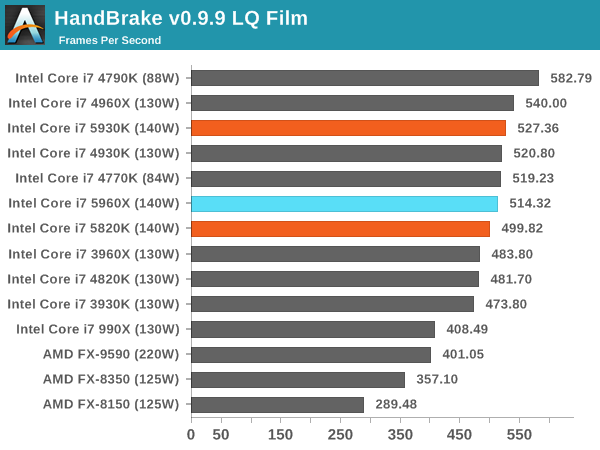
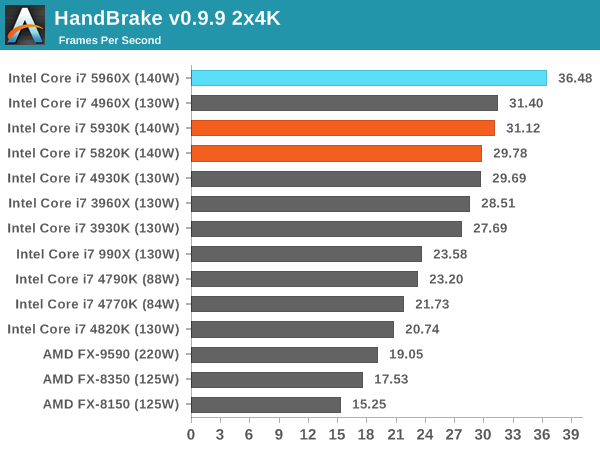
The variable turbo speeds of the CPUs results in a small difference in low quality conversion, and the high single core frequency of the 4790K wins there. For 4K conversion the problem becomes more parallel and the extra cores of the 5960X push it ahead of the pack. The 5930K and 5820K are both behind the 4960X however.
Agisoft Photoscan – 2D to 3D Image Manipulation: link
Agisoft Photoscan creates 3D models from 2D images, a process which is very computationally expensive. The algorithm is split into four distinct phases, and different phases of the model reconstruction require either fast memory, fast IPC, more cores, or even OpenCL compute devices to hand. Agisoft supplied us with a special version of the software to script the process, where we take 50 images of a stately home and convert it into a medium quality model. This benchmark typically takes around 15-20 minutes on a high end PC on the CPU alone, with GPUs reducing the time.
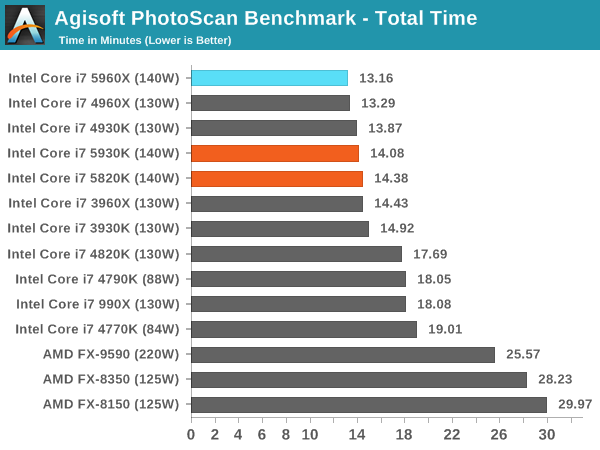
Photoscan's four separate components rely on different amounts of high frequency vs. many cores: check our Bench database for more detailed results but overall the 5960X comes out on top. That being said, the 5820K is less than 40% of the price and is only 1.2 minutes behind.
Dolphin Benchmark: link
Many emulators are often bound by single thread CPU performance, and general reports tended to suggest that Haswell provided a significant boost to emulator performance. This benchmark runs a Wii program that raytraces a complex 3D scene inside the Dolphin Wii emulator. Performance on this benchmark is a good proxy of the speed of Dolphin CPU emulation, which is an intensive single core task using most aspects of a CPU. Results are given in minutes, where the Wii itself scores 17.53 minutes.
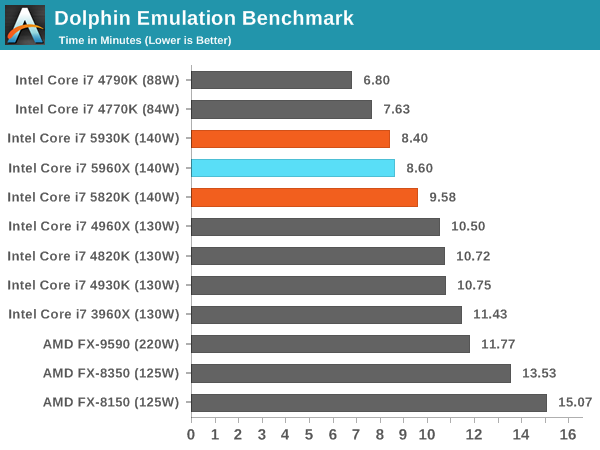
Dolphon loves single core speed and efficiency, meaning the 4790K wins out again. Interestingly the large L3 cache of the 5960X also helps here against the 5820K, despite the 5820K having a higher single thread frequency.
WinRAR 5.0.1: link
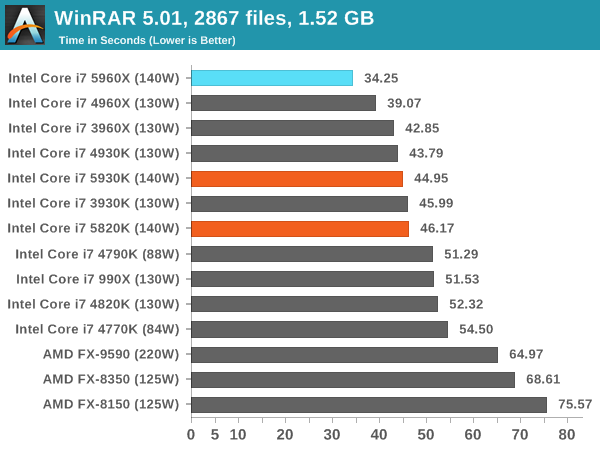
WinRAR is a variable thread workload, but more cores still wins out. Interestingly the xx60X CPUs are ahead of the xx30K CPUs followed by the xx20K. After this comes the 4790K, and then the 990X on par, showing how far three generations of Intel CPU have developed.
PCMark8 v2 OpenCL
A new addition to our CPU testing suite is PCMark8 v2, where we test the Work 2.0 and Creative 3.0 suites in OpenCL mode.
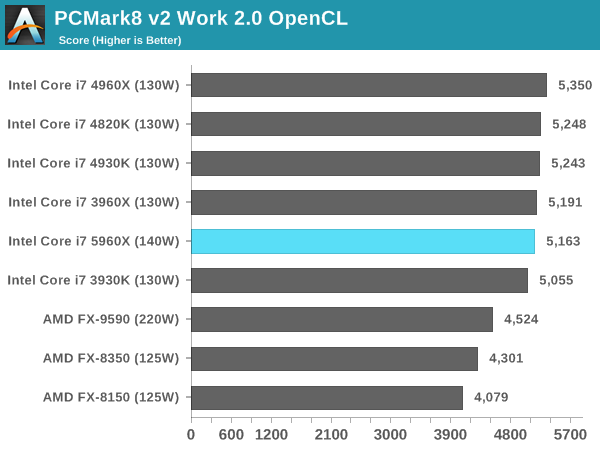
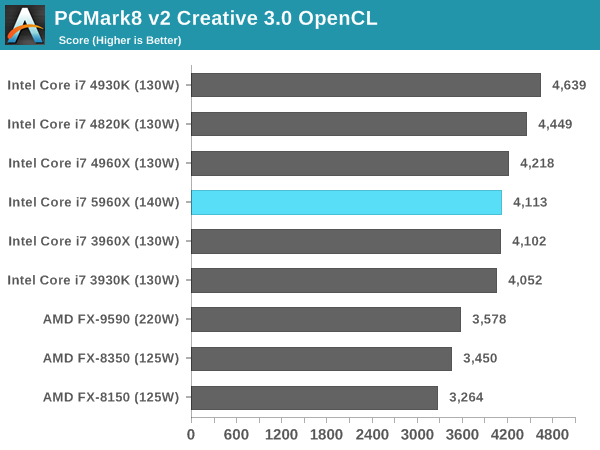
PCMark v8 relies on a number of factors, and it would seem that frequency is preferred over cache and memory. Interestingly the 4930K beat the 4960X in the Creative Suite with no obvious explanation.
Hybrid x265: link
Hybrid is a new benchmark, where we take a 4K 1500 frame video and convert it into an x265 format without audio. Results are given in frames per second.

Converting 4K video gets another step in the preference for more cores in Hybrid x265. The 5820K matches the 3960X, showing the progression of CPU generational development.
Cinebench R15
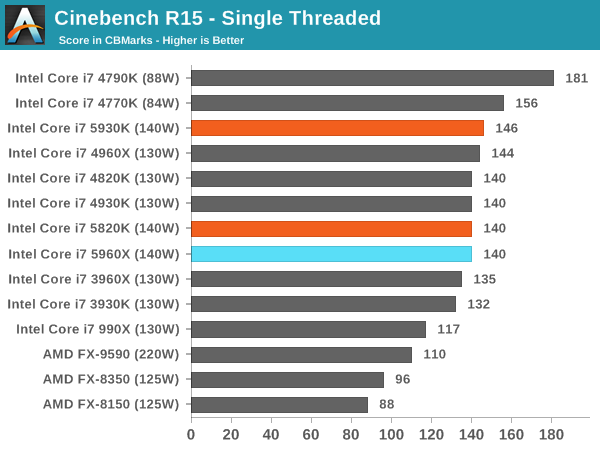
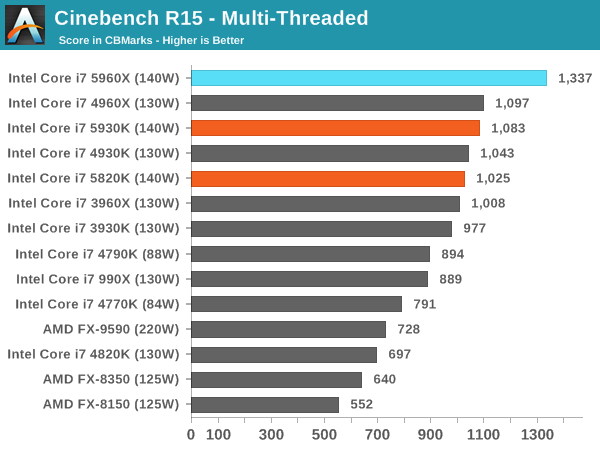
3D Particle Movement
3DPM is a self-penned benchmark, taking basic 3D movement algorithms used in Brownian Motion simulations and testing them for speed. High floating point performance, MHz and IPC wins in the single thread version, whereas the multithread version has to handle the threads and loves more cores.
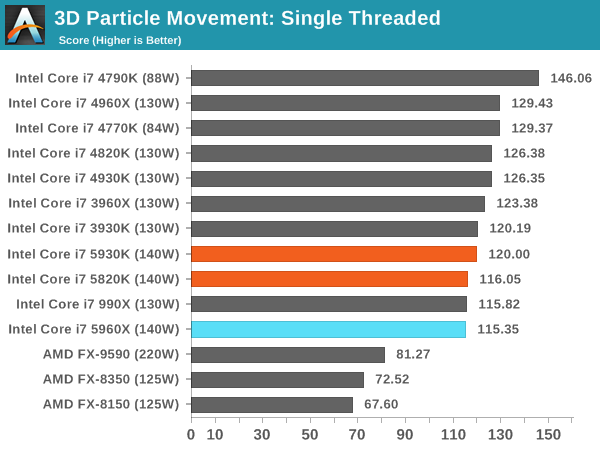

FastStone Image Viewer 4.9
FastStone is the program I use to perform quick or bulk actions on images, such as resizing, adjusting for color and cropping. In our test we take a series of 170 images in various sizes and formats and convert them all into 640x480 .gif files, maintaining the aspect ratio. FastStone does not use multithreading for this test, and results are given in seconds.
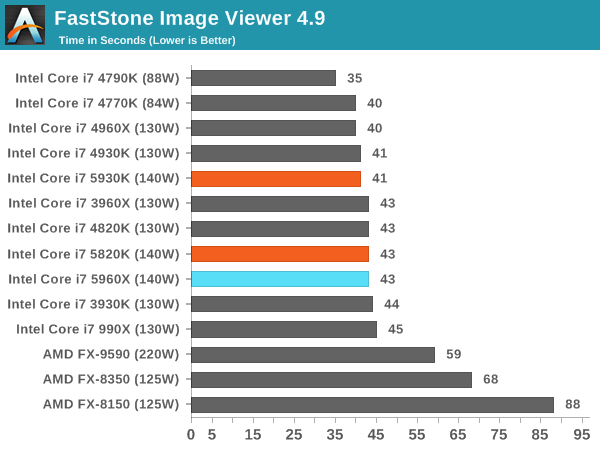
FastStone is a purely single threaded exercise, showing here how the lower core CPUs with high turbo perfom best, and by quite a margin.










203 Comments
View All Comments
tuxfool - Saturday, August 30, 2014 - link
I'm not so sure it would be of great benefit. Emulators are thread limited by the hardware they're attempting to emulate. I read somewhere that pcsx has a thread limit due to the difficulty in synchronizing each ps2 hardware component in each thread.Dolphin also favors clock speed over simultaneous threads.
bleh0 - Saturday, August 30, 2014 - link
After holding off for 4 years I think it is time for an upgrade. While the builds in the article are good I'm still looking for more.chizow - Saturday, August 30, 2014 - link
Glad I upgraded to Z87+4770K last year. While it is great that Intel *FINALLY* upgraded the rest of their platform to native USB 3.0 and all SATA3 (6G) ports, along with newer options like M.2 and SATA Express, the drop in clocks to accommodate the higher number of cores and higher resultant TDP makes it a wash for my primary purpose: gaming.I also didn't want to have to pay early adopters tax on DDR4, and it looks like that tax is high right now. Coming from X58, I was also very pleased with the drop in total system power going to Z87. I'd estimate between a 920@4GHz and the difference in board power, its pulling about 50W less at idle and 100W less under load. My Kill-A-Watt measurements indicate similar.
Still, if buying today and putting together a new platform for the future, this would be a good option now that Intel has addressed all of the major issues I had with the X79 platform (full native USB 3.0, full native SATA6G, official PCIe 3.0 etc).
@Ian, I am sure it is due to being limited to what you have on hand, but it would have been nice to see some more powerful GPUs tested, just to better illustrate potential CPU performance differences once the GPU bottleneck is lifted. Nice job though, the new graph toggles are really slick.
AsakuraZero - Saturday, August 30, 2014 - link
i was worried about this new processors since i just bought an i7 4770k, and damn im still a happy owner of an amazing chipTEAMSWITCHER - Saturday, August 30, 2014 - link
I pulled the trigger on the 4770K last year also....but I did so only because the Ivy Bridge E was stuck on the X79 chipset. For me, it was an interim solution while I waited for Haswell-E. When my new X99 parts arrive next week, I'll upgrade my system and put the Haswell parts on craigslist - I should be able to sell them for a bargain price and reclaim some cash.AsakuraZero - Sunday, August 31, 2014 - link
the 4770k still sells well on ebay i got mine at 270 (used) looked like new and works likea champ, Haswell e doesnt look bad but in a world where the x86 doesnt use all the cores on many of its applications, or gaming im happy with my purchase, enjoy your CPU and milk every buck out of it!Jonathan_Rung - Saturday, August 30, 2014 - link
"With Haswell LGA1150 CPUs, while the turbo frequency of the i7-4770K was 3.9 GHz, some CPUs barely managed 4.2 GHz for a 24/7 system."I think I spotted a little typo on page 3, did you mean "With Haswell z87..."? I didn't think any of the 4770x CPUs could use an 1150 socket. Or am I misreading it?
Mr Perfect - Saturday, August 30, 2014 - link
The Haswell i7-4770k is socket 1150.http://www.newegg.com/Product/Product.aspx?Item=N8...
Jonathan_Rung - Saturday, August 30, 2014 - link
Oh, you're right. I guess I'm confusing sockets and chipsets. Obviously CPUs need a matching socket, but do they also need a matching chipset, or do newer motherboards just allow newer feature sets introduced by the cpu? Or am I still getting it wrong?It seems like every time a new generation of CPUs are released, a bunch of new motherboards with identical chipsets show up to compliment them, so I thought each generation of CPUs have matching chipset that need to pair with one another.
Sorry, this is like amateur hour, I'll just google this stuff. It's strange, I like reading these articles, but I haven't the slightest idea why - I only understand what they're saying like half of the time!
mcbowler - Saturday, August 30, 2014 - link
at least my dolphin rating is still on top! not sure why that is important.